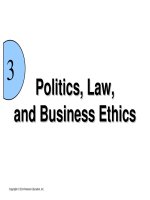Lecture International business (11/e) - Chapter 14: Organizational design and control
Bạn đang xem bản rút gọn của tài liệu. Xem và tải ngay bản đầy đủ của tài liệu tại đây (508.01 KB, 31 trang )
chapter fourteen
Organizational Design and
Control
McGrawHill/Irwin
International Business, 11/e
Copyright © 2008 The McGrawHill Companies, Inc. All rights reserved.
Learning Objectives
Explain why the design of organizational structure
is important to international companies
Discuss the organizational dimensions that must
be considered when selecting organizational
structures
Discuss the various organizational forms available
for structuring international companies
Explain the concept of the virtual corporation
14-3
Learning Objectives
Explain why decisions are made where they are
among parent and subsidiary units of an
international company
Discuss how an IC can maintain control of a joint
venture or of a company in which the IC owns less
than 50 percent of the voting stock
List the types of information an IC needs to have
reported to it by its units around the world
14-4
Organizational Structure
• Organizational structure
– The way that an organization formally
arranges its domestic and international units
and activities, and the relationships among
these various organizational components
14-5
Organization Design
• Organization design for international
– how an international business is organized in order
to ensure worldwide business activities are able to
be integrated efficiently and effectively
• Structures and systems must be consistent with
each other and with the environmental context
• Size and complexity of the organization must be
considered
• Structure must be able to evolve over time in
order to respond to change
14-6
The relationship among International
Environment, Competitive Strategy, and
Organizational Structure
14-7
Design Concerns
• Find the most effective way to
departmentalize to take advantage of
efficiencies gained from specialization of
labor
• Coordinate the activities of those
departments to enable the firm to meet
its overall objectives
14-8
Design Dimensions
• Product and technical expertise
regarding the businesses
• Geographic expertise regarding the
countries and regions
• Customer expertise regarding the client
groups, industries, market segments, or
population groups
• Functional expertise regarding the value
chain activities
14-9
Evolution of the International Company
• International Division
– A division in the organization that is at the same
level as the domestic division and is responsible for
all non-home country activities
• Worldwide organizations were established, as
a result of growth
–
–
–
–
Product
Function
Region
Customer classes
14-10
Evolution of the International Company
14-11
Global Corporate Form
• Product
• Geographic
14-12
Global Corporate Form
• Function
• Hybrid Forms
14-13
Global Corporate Form
• Matrix Organizations
– Matrix overlay
• An organization in which top-level divisions are required to
heed input from a staff composed of experts of another
organizational dimension in an attempt to avoid the double
reporting difficulty of a matrix organization but still mesh
two or more dimensions
14-14
Global Corporate Form
• Strategic Business Unit
– Business entity with a clearly defined
market, specific competitors, the ability to
carry out business mission, and a size
appropriate for control by single manager
14-15
Changes in Organizational Form
• Result from pressure to act more quickly,
reduce costs and improve quality
• Reengineering to
–
–
–
–
–
–
–
reduce levels of middle management
restructure work processes
reduce fragmenting across departments
Improve speed and quality of strategy execution
Empower employees
Communicate instantly
Transmit information swiftly
14-16
Current Organizational Trends
• Virtual
Corporation
– An organization that
coordinates
economic activity to
deliver value to
customers using
resources outside the
traditional boundaries
of the organization
• Advantages
– Permits greater
flexibility
– Forms a network of
dynamic relationships
taking advantage of
the competencies of
other organizations
• Disadvantage
– Potential to reduce
management’s control
over the corporation’s
activities 14-17
Current Organizational Trends
• Horizontal Corporation
– A form of organization characterized by lateral
decision processes, horizontal networks, and a
strong corporate wide business philosophy
– Employees worldwide create, build, and market
products through cultivated system of
interrelationships
14-18
Control
• Where Are Decisions Made?
– All at IC headquarters
– All at subsidiary level
– Combination
14-19
Control
• Variables determining the location of decision making
–
–
–
–
Product and Equipment
Competence of subsidiary management
Size of international company and duration
Detriment of a subsidiary for the benefit of the
enterprise
– Level of subsidiary frustration
14-20
Control
• Subsidiaries
– Companies controlled by other companies
through ownership of enough voting stock to
elect board-of-directors majorities
• Affiliates
– A term sometimes used interchangeably
with subsidiaries, but more forms exist than
just stock ownership
14-21
Control
• Product and Equipment
– Existence of global product policy
– Degree standardized or localized
14-22
Control
• Competence of Subsidiary Management
depends on
– How well executives know one another
– How well executives know company policies
– Whether headquarters management feels it
understands
• Host country conditions
• Distances between home and host countries
• Size and age of parent company
14-23
Benefiting Enterprise Detriment of
Subsidiary
• Subsidiary detriment
– Situation in which a small loss for a subsidiary
results in a greater gain for the total IC
• Moving Production Factors
– Cost, labor, taxes, market, currency, political stability
• Which Subsidiary Gets the Order?
– Transportation, production, tariffs, currency, backlogs
• Multicountry Production
– Economies of scale
• Which Subsidiary Books the Profits?
– Taxes, currency controls, labor relations, political climate,
social unrest
14-24
Subsidiary Frustration
• Subsidiary Frustration
– Management of subsidiaries must be
motivated and loyal
• If all decisions made at HQ they can lose
incentive and prestige or face with their
employees and the community
• They may become hostile and disloyal
14-25









